Ryan Hall's Blog, page 359
August 29, 2015
Double Gold For Mo Farah—Again
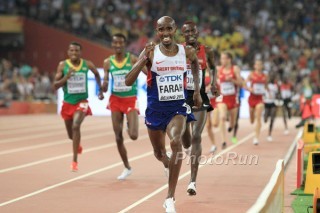
Mo Farah outkicked the field over the final 400m to win the world 5,000m title on Saturday. Photo: PhotoRun.net
(c) 2015 Race Results Weekly, all rights reserved. Used with permission.
BEIJING — For the third consecutive global championships beginning with the London Olympics in 2012, Britain’s Mo Farah completed the 5000m/10,000m double, winning the shorter event with a heart-pounding homestretch run against Kenya’s Caleb Ndiku at National Stadium. Off of a very slow early pace, his winning time of 13:50.38 was the slowest in the history of the IAAF World Championships.
“They’ve all been difficult,” Farah said of his three double gold performances at the 2012 Olympics and 2013 and 2015 World Championships. “It’s never easy to continue double/double.”
For nine of the 12 and one-half lap race, the pack dawdled along, running 400m circuits as slow as 73 seconds. Lap after lap, Farah ran in last place, staying away from potential trouble and conserving energy.
“I was really pleased early on when the pace was so slow,” Farah said at his post-race press conference. “From that point on I was really trying to relax and see what I could do towards the last lap.”
With seven laps to go, Farah moved up on the outside of the field, and settled in near the front. The pace dropped a bit to 68 seconds, then 66, still not fast enough to whittle down the pack. Ndiku, last year’s world indoor 3000m champion, saw that the pack was still too big and knew needed to take action. He waited for 800 meters to go, then launched an explosive move to break up the race.
“For tonight, the race was very technical,” Ndiku said. “Eight hundred meters to go, everybody was in the pack. Then, I decided to split the pack… I knew the last lap would be very fast. So, I had to push hard to break the group.”
Ndiku ran a 58.4 second lap, followed by another at 54.3, too much for everyone else in the field except for Farah. With 200 meters to go, he was leading the Briton by two steps with Ethiopia’s Hagos Gebrhiwet and Yomif Kejelcha a few steps behind.
“Ndiku really put his foot down with two laps to go,” Farah observed.
Coming into the homestretch it was still a two-man race, but Farah had saved something for the end. He put in one more acceleration, finally pulling away from the exhausted Ndkiu. Spreading his arms to the side, he crossed the finish line as the crowd roared with approval.
“Ndiku is a great athlete,” said Farah. “He’s a class athlete, and he’s still young. Tonight, he really put his mark down. He definitely tested me.”
Ndiku clocked 13:51.75 to get the silver, and was not disappointed.
“For me, getting the silver was the best moment, ever, because I was not expecting that,” he said.
Gebrhiwet, who had won the silver at these championships in Moscow two years ago, had to settle for bronze. His time was 13:51.86, about half a second up on the teenager Kejelcha.
Behind the podium finishers, Americans Galen Rupp, Ben True and Ryan Hill finished fifth, sixth and seventh, respectively, the first time ever that the United States placed three athletes in the top-7 at these championships.
“I was trying to stay in position the whole time and give myself a chance,” said True. “I let them jump me a little bit. I thought I was right there with 600 to go, right where I wanted to be. But, they kind of jumped me with 500 to go.”
In the women’s 800m, Marina Arzamasova of Belarus won her nation’s first ever medal in that event at these championships, winning a surprisingly tactical contest over Canada’s Melissa Bishop (silver) and Kenya’s Eunice Sum (bronze).
“Of course I expected the podium,” said Arzamasova, who clocked 1:58.03. “After the semifinals, I expected [the] gold medal.”
Hers was an odd race. Sum, the defending champion, shot out from the start, running the first 200 meters in a blistering 27.2 seconds. But then she slammed on the brakes, and the 400 meter split was only a modest 59.1 seconds.
“Normally, I’m a front runner,” Sum later explained. “I was really doing my tactics as usual.”
On the backstretch, Arzamasova increased the pace, and both of the eventual medalists responded. She kept the lead coming out of the final bend, running in lane two with Bishop on her left and Sum on her right. She had only half a stride on her rivals, but it was enough.
“Of course, I’m really honored to get this medal for my country, my family,” said Arzamasova, choking up. “I really don’t have any words.”
Bishop, who set a Canadian record in the semifinals, was thrilled to get silver. Her coach, Dennis Fairall, told reporters that “she was content to get in the final.” She earned Canada’s seventh medal at these championships, adding to the teams already record total.
“It’s a feeling of pride,” Bishop said. “We have a really great generation and group of athletes in Canada right now. We’re working really hard to put ourselves on the map. I’m really happy to be part of that medal count.”
The post Double Gold For Mo Farah—Again appeared first on Competitor.com.
10 Years After Katrina, New Orleans Running Community Stronger Than Ever
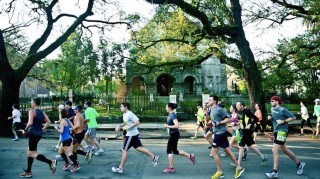
Photo: Ryan Bethke
When she evacuated her New Orleans home before Hurricane Katrina unleashed its fury on the Crescent City, Betsy Boudreaux didn’t take much with her. One item she did grab was her medal from the 2005 Mardi Gras Marathon.
Even if she had left it behind, Boudreaux still would have carried a reminder of the race. The medal is tattooed on the inside of her left ankle.
“That’s how much it means,” says Boudreaux, a former member of the New Orleans Track Club’s board of directors.
This weekend marks the 10th anniversary of Hurricane Katrina, which was responsible for at least 1,245 deaths and more than $108 billion in property damage. The New Orleans running community demonstrated its resiliency in the hurricane’s aftermath.
In early November 2005, barely two months after Katrina, the New Orleans Track Club put on an informal 5K run.
“No timing chips,” recalls Brandan Minihan, a longtime New Orleans runner who says about 150 people showed up for the run. “It just showed everyone we were back, that we were going to keep putting on races.”
On Thanksgiving Day, the club staged its annual 8K Turkey Day run, which dates back to 1907.
Then, on February 5, 2006, the city staged the Mardi Gras Marathon. Some 2,148 runners finished the race in what is believed to be the first major sports event in the city after Katrina.
“It was important for the running community,” Boudreaux says of the Mardi Gras Marathon. “It was important for the city. It was important just to show some sort of normal. We had to get back to something that felt right, that could take your mind off of everything you were dealing with, whether it was rebuilding your house, insurance. It was something to take you back to the way it used to be.”
Minihan, now 40 years old, won the 2006 Mardi Gras Marathon in 2:36:44.
“To have won that race,” says Minihan, who grew up and still lives in New Orleans, “it was one of the proudest moments of my life.”
More than five months after Katrina’s destruction, Minihan remembers the marathon course showed many of the city’s scars.
“You could see water lines on houses, dead trees,” he recalls. “It was scenic, in a kind of dark, morbid way.”
During the weekend, Minihan took time to thank people from out of town for coming to New Orleans for the race.
“It was like we were opening up our city to the running world,” says Minihan. “I was also proud of all the locals who showed up to represent the running community. It meant we were strong. We were going to be as strong or stronger.”
One of Minihan’s friends, Tom Sawyer, finished second in 2:39:05.
“We wanted to go out there and represent New Orleans and we wanted to compete,” says Minihan. “It wasn’t a fun run.”
Sawyer evacuated New Orleans before Katrina struck and didn’t return for five weeks. Upon returning, he remembers running over piles of rubble, tree limbs and furniture in the city.
“It was almost like were weren’t going to take no for an answer,” says Sawyer. “We were going to do what we wanted to do, no matter what barriers you put in front of us.”
Says Boudreaux, “Our city is so unique. We use every opportunity to celebrate. We celebrate funerals. We have a tomato festival. We celebrate the tomato! We use celebrations as a common expression.”
In 2010, the Mardi Gras Marathon was rebranded as part of the Rock ‘n’ Roll Marathon Series. The Rock ‘n’ Roll New Orleans Marathon & 1/2 Marathon attracted more than 10,000 finishers last year, nearly a 500 percent growth from the 2006 Mardi Gras Marathon and Half Marathon.
“Rock ‘n’ Roll has allowed the marathon to reach people we would never have reached before,” says Boudreaux. “It definitely has afforded us the opportunity to grow and showcase the New Orleans running community in a way we never would have been able to on a local level.”
The post 10 Years After Katrina, New Orleans Running Community Stronger Than Ever appeared first on Competitor.com.
August 28, 2015
Shoe Talk: ASICS GEL-Kayano 22
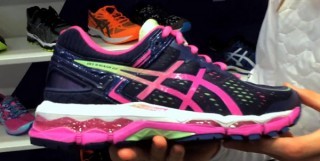
A longtime favorite of many runners, the ASICS GEL-Kayano is back with some significant updates. Let’s take a look.
RELATED: Shoe Talk: New Balance Vazee Pace
The post Shoe Talk: ASICS GEL-Kayano 22 appeared first on Competitor.com.
3 Exercises to Build a Better Butt
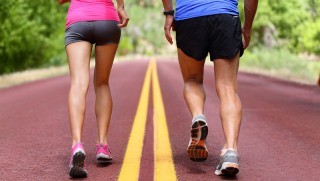
This article first appeared on Women’s Running.
Squats and lunges are great for building your glutes, but they can miss your gluteus medius—or the side of the butt. Those muscles are key in the quest for a firmer derriere.
David Kirsch, founder of David Kirsch Wellness Company and author of the upcoming book, David Kirsch’s Ultimate Family Wellness: The No Excuses Program for Diet, Exercise and Lifelong Health (December 2015), has three signature moves that will tighten the side of your tush and lead you to a better butt.
Photo Gallery
1 of {count}
Back to Start
View Larger Image

Sumo Lunge With Side Kick
(1) Stand in a "sumo" position with your feet slightly wider than hip width, knees bent, and your body weight in your heels. (2) Take a large step sideways with your right leg, bringing your right knee in toward your chest and then over to the right in one continuous motion. (3) As soon as your right foot touches the ground, bring your knee back into your chest and complete a side kick, kicking your right heel out to the side into the stomach of an imaginary opponent (or jaw, if that imaginary person is height-compromised). (4) Lower your right leg to the floor into the sumo position. Squat down while sticking your butt out. Keep your knees just above (not in front of) your toes. (5) Spring up while thrusting your arms overhead. Land on your heels, rolling forward onto your toes. Repeat with a sumo lunge and side kick with your left leg and another frog jump. Continue alternating right to left until you have completed 10 lunges on each side and 20 frog jumps.
View Larger Image
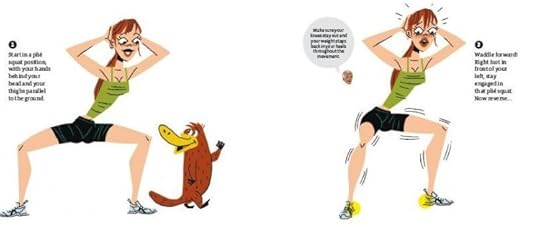
Platypus Walk
(1) Grab a medicine ball with both hands and extend your arms overhead. Squat in a sitting position with your knees aligned with your toes and your butt sticking back as far as you can get it. (2) Keep your core tight as you walk forward, pushing off through each heel. If you perform the move correctly, your butt and inner thighs will be on fire. Walk across the room in one direction and then reverse and walk backward. If your room is small, repeat crossing the room one time.
View Larger Image
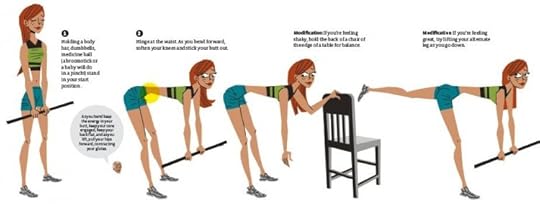
Bent Left Deadlift
(1) Holding a body bar, dumbbells, medicine ball, or even a broomstick in a pinch, stand with your legs shoulder-width apart. (2) Bend forward, hinging at the waist. Keep your knees soft and back flat. Come back to starting position. (3) Make it easier: If you're feeling shaky, hold the back of a chair or the edge of a table for balance. (4) Make it harder: If you're feeling great, try lifting your alternate leg as you go down.
Related Galleries
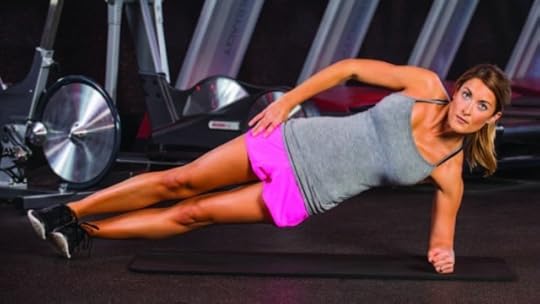
A Pre-Run Core Workout Using Body Weight

Strength Training for Runners: Weighted Lunges
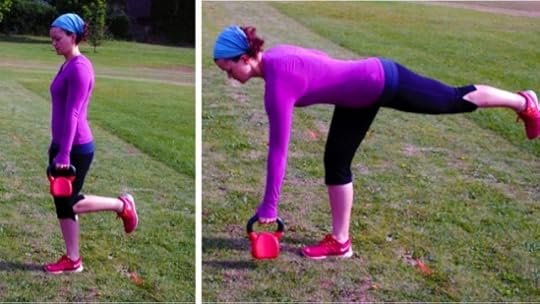
5 Kettlebell Exercises for Runners
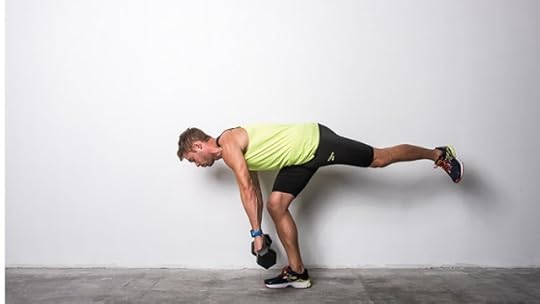
Strength Training for Runners: Single-Leg Deadlifts

More Galleries
The post 3 Exercises to Build a Better Butt appeared first on Competitor.com.
Does The Average Runner Care About USATF?
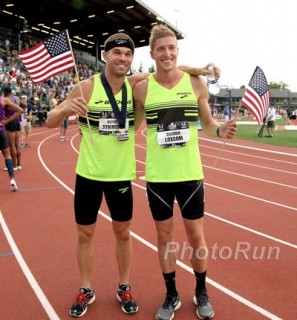
Recent issues between USATF and athletes like Nick Symmonds (left) has captured headlines. But how much does the average runner care? Photo: PhotoRun.net
In recent weeks, the running world has been rocked by a series of scandals. And USA Track and Field has been at the heart of much of the bad press, from doping tell-alls that point fingers at current stars and past medal winners to complaints about the demands being made by corporate sponsors (highlighted by 800m national champion Nick Symmonds’ refusal to sign USATF’s statement of conditions ahead of the world championships). Runners must be outraged and calling for blood. Right?
Uh, not exactly.
USATF isn’t sure that most average runners know it exists. In a series of outreach events the governing body conducted in 2012 at eight of the biggest track meets of the year, only 65 percent of the people surveyed had even heard of USA Track and Field and only 39 percent were members. This suggests that even among track and field fans, who are already a niche crowd, there is a niche inside that of the hardcore fans who actually know and care about the details of what USATF does for the sport.
And the number one thing that people said would motivate them to join USATF? Not reform, but merchandise.
James Chu and Heather Irvine are both members of the North Brooklyn Runners, a community running group in New York City. So, what has the group been talking about lately on their email listserves and discussion forums? Chu and Irvine will send along articles or links to keep everyone informed about the hottest issues in the running world, but mostly, said Chu, people just want to train for and run a marathon. They don’t identify with professional track runners, because the last time they probably ran in a track meet was in high school.
The group did debate the recent doping allegations surrounding Alberto Salazar, said Irvine. But, what about the whistleblower allegations that suspicious blood tests at the international level were covered up? Or the saga of Symmonds’ fight with USATF over what athletes can be required to wear?
“Not many people discussed it, actually,” said Irvine.
According to Symmonds, he’s been getting plenty of feedback on social media and support from runners at meets or out on trails—though, presumably, those runners who recognize Symmonds are slightly more dedicated track fans. “I would say it’s been 95 percent positive,” he said.
If there are millions of runners in the country and most of them don’t pay that much attention to the ins-and-outs of track and field, then what do they care about?
I’m going to guess that the 2 billion people around the world who watched Usain Bolt’s 100m final at the London Olympics weren’t watching because they could name the other seven people in the race. In the U.S., where that race wasn’t aired live, another 1.2 million people streamed it live online. (That’s a lot of people, but not as many as those who streamed the women’s gymnastic team final or the women’s soccer final during that same Olympics.)
For comparison, around 1.5 million people per night watched NBC’s TV coverage of the last IAAF Track and Field World Championships. And if you guessed that the night that had the most viewers during the 2011 World Championships was the night of Bolt’s 100m DQ, then you’d be right.
People care about the marathon, the 100m, and the Olympics.
This isn’t to say that plenty of athletes aren’t trying to connect with fans in other ways, to get people to care about more than those three things. But as this year’s World Championships come to a close in Beijing, it’s not even clear that the people who do follow track and field news are all forming the same opinions. A perusal of the comments on any Facebook post about running from Competitor, Universal Sports, or Runner’s World shows that for all the people who agree with Symmonds, there are some who think he’s in the wrong. For everyone who’s upset about ex-dopers in the sport, there were far more excited about two Gatlin vs. Bolt showdowns.
At the IAAF meeting held in advance of the championship meet, the five U.S. candidates for international federation committee seats all won election, including USATF President Stephanie Hightower. This is an unprecedented victory for USA Track and Field at the IAAF level—and that’s despite the fact that the nomination of those same candidates at the USATF meeting back in the fall prompted outrage from track insiders over the voting process and what is seen as reforms needed at the national level. Someone thinks they’re doing something right.
The main time USATF comes into the public eye (whether they could do anything to change that or not) is when they are blamed or praised for the performance of the U.S. team. As long as American track and field athletes win medals in Beijing (as of Friday night, the U.S. was leading the overall medal count with 14) and next year in Rio, almost all else will likely be forgiven.
The post Does The Average Runner Care About USATF? appeared first on Competitor.com.
CEP Connect: Recover Faster With Compression Apparel
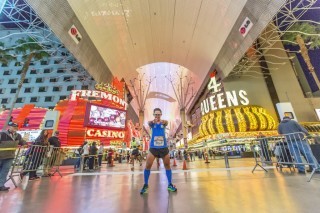
Research finds that compression expedites recovery for marathoners.
At 40 and still competing at the top level, Meb Keflezighi remains the most dominant American marathoner in history. The 2004 Olympic silver medalist in the marathon won the 2009 New York City Marathon and the 2014 Boston Marathon and is the only American to win both big city marathons and an Olympic medal.
His longevity as an elite runner has been aided by his balanced training regimen, which incorporates core-strengthening and cross-training, along with a strict diet. But it’s also been helped by his penchant for wearing compression socks.
Like Olympic bronze medalist Shalane Flanagan and Chris Solinksy, the first American to run a sub-27 minute 10K, Meb wears compression socks not only for recovery but during his key races.
Recent research suggests that compression socks clearly enhance your recovery from hard workouts and races, allowing you to return to running sooner, which provides you with a competitive training advantage.
A study published in February of this year in the Journal of Strength and Conditioning Research by a group of Australian and New Zealand scientists offers some of the clearest evidence. It examined 33 runners, some of whom wore below-knee compression socks for 48 hours after a marathon, and found that those who recovered with compression socks were able to run on average significantly longer on a graded treadmill test 14 days after their marathon than the control group that didn’t wear compression socks.
“In the compression group, average treadmill run to exhaustion time two weeks after the marathon increased by 2.6 percent,” the researchers reported in their study. “In the placebo group, run to exhaustion time decreased by 3.4 percent. This shows a significant beneficial effect of compression socks on recovery.”
A review of 12 other studies on compression socks published in the British Journal of Sports Medicine last year reached a similar conclusion about the recovery benefits of compression. It concluded that compression garments had a “moderate” effect in reducing delayed onset muscle soreness after tough workouts and allowed damaged muscle tissue to regain its power and strength. “These results indicate that compression garments are effective in enhancing recovery from muscle damage,” the researchers said in their study.
Originally developed to improve blood circulation and prevent blood clots in people with deep vein thrombosis and other problems, compression socks squeeze the blood that normally pools in your feet when you’re sitting or standing and helps send it up toward your heart. There, the blood is re-oxygenated by your lungs and then sent back down to more quickly to repair the muscle damage in your legs.
When you’re running, contractions from the muscles in your legs act like a pump to send the blood that would otherwise pool in your lower legs through your circulatory system. That may be why most researchers who’ve studied the issue have not yet found a performance benefit from running with compression socks.
Nevertheless, it’s clear that compression socks, calf sleeves, shorts and tops can keep your muscles warm and improve blood flow during runs on cold days. Compression socks provide an extra bit of stability for your ankles and calves when you’re running on an uneven trail. And the spandex-like fabrics in compression garments allow your body to efficiently wick sweat away, which can prevent chafing and blisters when you’re hot and sweaty.
However you decide to use them—whether for running or to recover more quickly from your hard runs or races—make sure your compression socks fit properly. The best manufacturers sell socks fitted specifically to your left and right feet and require you to measure the diameter of your calves to get a properly fitted pair. Also make sure the compression sock or calf sleeve you purchase is graduated—tighter at the ankle than at the top of the calf to promote venous blood return and has 20-30 mmHg of moderate compression, which is considered ideal for performance and recovery.
Shop medical-grade CEP Compression socks.
The post CEP Connect: Recover Faster With Compression Apparel appeared first on Competitor.com.
Mountain Running 101: Going Up Isn’t All There Is To It
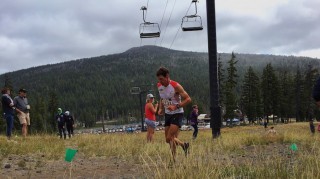
Max King makes his way up Mt. Bachelor at the recent U.S. Mountain Running Championships. Photo: Mario Fraioli | Competitor
Running in the mountains isn’t easy, but it doesn’t always have to be difficult either. It’s one of those disciplines that is both inspiring and intimidating. Running uphill can be very challenging, but once on the top you’re treated to the best views, fresh air and an unmatched sense of accomplishment.
For the past few years the sport of trail running in general—and mountain running in particular—has been gaining popularity, with many traditional road runners beginning to enjoy the training and visceral elements the trails have to offer.
But how do you get started? How should you train? If you’ve ever visited or lived in a mountain community like Bend, Ore., Boulder, Colo., or Asheville, N.C., you know what running up a mountain can involve. But how can you get better?
The training involved for a mountain race is like a bag of trail mix with a little bit of everything thrown in. Let’s get to it.
The post Mountain Running 101: Going Up Isn’t All There Is To It appeared first on Competitor.com.
August 27, 2015
The Call of the Wild: Ultra-Trail du Mont-Blanc in Chamonix, France
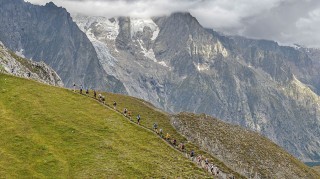
Runners tackle one of the many steep climbs on the UTMB course. Photo: UTMB
Martin Schneekloth had never been to Chamonix, France, before, so his reaction to seeing a portion of the Western Alps for the first time on Tuesday was almost palpable.
“Driving in from the airport in Geneva, when you first see Mont Blanc, it’s quite exciting, but also scary at the same time,” says Schneekloth, a 44-year-old ultrarunner from Huntsville, Ala.
Schneekloth, who is originally from Germany, traveled 4,702 miles to this charming mountain hamlet with awe-inspiring views to run the Ultra-Trail du Mont-Blanc (UTMB), a painstaking 104-mile trail running race that circumnavigates the biggest mountain range in Western Europe. It’s a ridiculously hard course with more than 66,000 combined feet of elevation gain and loss and considered by many to be the hardest ultra-distance event in the world.
But Schneekloth, like so many other hardy runners from around the world, was attracted precisely by the sheer magnitude of that challenge.
If Ironman triathlons became the “what’s next?” after the marathon in modern society, this call of the wild—namely running freakishly long races through ungodly mountain ranges—appears to be what comes after that for those who like to challenge their physical, mental and emotional limits.
RELATED: UTMB Course Stats via Trail Run Project
Mountain ultraunning isn’t a new sport; it at least dates back to the first unofficial Western States 100 in 1974 (when Gordy Ansleigh famously ran 100 miles of an equestrian race between Squaw Valley and Auburn, Calif., when his horse came up lame and couldn’t run) and has been growing ever since. However, the notion of traveling around the world to run in some of the most notable trail races is a relatively new phenomenon—both for elite runners and trail-hardened age-groupers too.
Representatives from dozens of ultra-distance events from every corner of the world have been on hand at the UTMB race expo, trying to attract this week’s hardy participants to their race. Plus, those interested in running the UTMB and the other races in Chamonix need qualifying points earned in those races to gain entry.
“I’m here because of the challenge of the big mountains and the Alps themselves,” says John Hallsten, a 58-year-old carpenter from Helena, Mont. He’s been running ultras since the late 1990s and has five finishes of Colorado’s daunting Hardrock 100—largely considered North America’s toughest ultra— to his credit. To date, he’s run 17 100-milers and finished every single one of them. “I have wanted to come to the Alps since I was about 8 years old and this race gave me the opportunity to do that. I decided before I turned 60 that I’d come over and do this race.”
The 13th annual UTMB begins on Friday evening (noon ET in the U.S.) in Chamonix and will send more than 2,500 runners on an arduous journey around the Mt. Blanc massif and its namesake, 15,782-foot peak that towers over the region like a snow-covered skyscraper. It’s the fifth and final race during the week that annually celebrates the pinnacle of trail running amid the rugged mountains and breathtaking scenery in parts of France, Italy and Switzerland. Other race distances include the 50K Osieres-Champex-Chamonix (OCC), 101K Courmayeur-Champex-Chamonix (CCC), 119K Sur les Traces des Ducs de Savoie (TDS) and the 300K La Petite Trotte a Leon (PTL) and each one has a menacing amount of vertical relief.
It’s a reason most runners carry lightweight trekking poles and wear small backpacks with hydration, fuel and various pieces of mandatory gear.
“Yeah, it’s the sheer amount of vertical you can gain in any given mile that sets this place apart,” says American Sage Canaday, who is wearing race bib No. 1 in the UTMB because he’s atop the current International Trail Running Association (ITRA) rankings. “The trails are relatively smooth, but you could easily gain 1,000 feet in a mile and not even think about it. Every climb on the course is just very big and epic. It’s like 4,000 feet up, then 4,000 feet down on super steep trails.”
Even though he’s one of the world’s top mountain runners and owns a 2:15 marathon PR, Canaday is in awe of the local topography as much as anyone else. But he’s not the least bit sheepish about the challenge in front of him, even though this will be his debut at the 100-mile distance. He’s been training in Chamonix for almost a month to get prepared for the race.
“I say I like to try to run ‘any surface, any distance,’ so I wanted my first 100 to be a high-profile race on a big stage in an epic mountain environment where I thought the odds might be kind of stacked against me,” says Canaday, a professional runner sponsored by Hoka One One and numerous other brands. “But part of it was I really wanted to explore these mountains, too, because they’re so beautiful.”
RELATED: Virtual Trail Run of the UTMB Course
This is the biggest year yet for the UTMB festival of races. This past winter, 15,500 runners from around the world applied to enter one of the races, but only 7,250 were accepted. The lucky ones who made it hail from 87 different countries. Aside from France, which claims more than 5,000 runners entered in one of the races, Japan is next with 300 runners while China, Brazil and the U.S. all have more than 100. Officially, there are 171 American runners entered in one of the five races (including a record 90 in the UTMB).
“There’s a lot more climbing here in a short distance than anywhere in the U.S., so it beats up your legs a lot more on the way down,” says David Laney, a 26-year-old Nike-sponsored athlete from Ashland, Ore., who won the grueling Chuckanut 50K in Bellingham, Wash., in March and placed eighth in the Western States 100 in June. “I kind of like that because it forces you to power hike quite a bit, which saves the legs to some extent.”
Aside from the unrelenting terrain, the other big difference in Chamonix (and most of Europe) is the attention trail running gets from the local communities.
“It’s pretty incredible, because you feel the energy when you’re walking through town,” says Tim Tollefson, 30, a Nike-sponsored trail runner from Mammoth Lakes, Calif., who is running in the 101K CCC race. “It’s more than a just one-day event. It’s a weeklong festival of sorts and because of that you get more than just a spectacular race, there’s an entire cultural experience centered around trail running.”
Americans elite runners have had a good amount of success at the UTMB since its inception in 2002, when Topher Gaylord and Brandon Sybrowsky tied for second and Krissy Moehl won the women’s race and placed 24th overall among 67 finishers. Nikki Kimball won the women’s race in 2007, while Moehl won again in 2009. American Rory Bosio won the women’s race the past two years, lowering the course record to 23:23 in the process.
But plenty of top-tier U.S. trail runners have been destroyed by the mountains and forced to drop out or struggle to the finish line, too. That includes Hal Koerner’s epic 38-hour sufferfest in 2011 and Anton Krupicka’s struggles the last two years when he had been contending for the lead but was forced to drop out in 2013 and struggled to the finish in 48th place last year.
“I’m not really nervous for this race as I am with other races, because I don’t really feel like I’m racing anyone as much as I’m just going to be trying to get around the dang course,” says Stephanie Howe, a runner sponsored by The North Face who won the Western States 100 in 2014 and finished second this year. “I have some personal goals, but really I want to be able to smile and enjoy the journey. However that happens, hopefully it won’t take me too long to get back to Chamonix.”
Other top Americans include Darcy Piceu (UTMB), Sally McRae (UTMB), Jeff Browning (UTMB), Magda Lewy-Boulet (CCC) and Zach Miller (CCC). A few are here to race, most just want to endure the adventure and reach the finish line.
RELATED: Chamonix, The Culture of Hard-Core Trail Running
Every level of competitor, no matter how fast or how experienced, winds up in awe of the mountains after running in Chamonix.
“’Intimidating’ was my first thought, because I’m running through those mountains, but aside from that it’s really it’s just amazing here,” Schneekloth says. “The mountains, the terrain, the steepness of the trails. Everything is bigger here. Normally they say that about America, but when it comes to ultrarunning I think it’s true here in the Alps.”
The post The Call of the Wild: Ultra-Trail du Mont-Blanc in Chamonix, France appeared first on Competitor.com.
Ultrarunner Ben Stern Hopes His Hard Work Pays Off At Headlands 50K
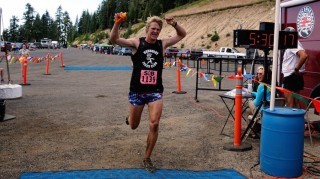
In July, Stern broke Ryan Ghelfi's course record at the Siskiyou Out Back 50 Mile by 2 minutes. Photo: Courtesy of Ben Stern
Covered in dirt and sweating from head to toe, Ben Stern smiles and takes a long swig of water to hydrate his depleted body as the Northern California sun intensifies on the open fields around him.
This is a familiar scene for the 24-year-old ultrarunner, who works five days a week at Little River Farm, an organic salad farm where he does “a little bit of everything” from digging up soil to planting, harvesting, washing, packing and delivering greens to local vendors.
“It’s some hard manual labor but I just really enjoy being active,” says Stern, who began working full-time at the farm last October. “And I’m outside almost 100 percent of the time, which is hard to beat.”
On Saturday, the Arcata resident will try hard to beat some of the best trail runners in the country when he lines up for the fifth ultra-distance race of his young post-collegiate career at the Tamalpa Headlands 50K, an annual Bay Area event, which this year doubles as the U.S. 50K Trail Championship. The race boasts a loaded field, including reigning U.S. mountain running champion Patrick Smyth of the Nike Trail Elite team, a 2:15 road marathoner who broke the course record earlier this year at the Way Too Cool 50K, Colorado’s Andy Wacker, runner-up to Smyth at the U.S. mountain running championships, two-time U.S. trail runner of the year Mario Mendoza, two-time national trail running champion David Roche, and a whole host of other off-road all-stars.
“When I signed up for the race I didn’t realize it was the national championships,” admits Stern, who will wear bib #9 on Saturday. “I just saw that it was local—the Bay Area is local for us up here—but now that I’ve seen how packed the field is, I’m not letting myself think that I’m not at their level. I would love to get a podium finish at this one and I’m not letting myself think that I can’t. If it’s a good day, it’ll be a good day, but if it’s not and I crash and bonk, I’ll at least know I tried.”
The unsponsored Stern made his ultrarunning debut last December at the Arcata to Willow Creek 40-Mile, an unsanctioned, underground event that has had at least one finisher every year since its inception in 1973. Stern broke the finish line tape made of toilet-paper in 4:46:12, an average pace of 7:09 per mile on the point-to-point road course along Highway 299 that traverses two mountain passes and features 6,000 feet of elevation gain. He defeated the race’s only other finisher, a woman in her 60s, by several hours.
In March, Stern lined up for his first official ultra race, the Gorge 100K in Oregon, where he ran with the leaders for the first two thirds of the race and ultimately finished third in 9:59:51. A little over a month later, he won the Miwok 100K in the Marin Headlands, clocking 8:50:45 to win by nearly 8 minutes. In late July, he won the Siskiyou Outback Trail Run, breaking Ryan Ghelfi’s 50-mile course record, clocking in at 6:30:17—30 minutes ahead of runner-up Hal Koerner, who was making his return to competitive ultrarunning after overcoming a long injury spell.
“I love the adventure aspect of ultra racing,” says Stern. “You get to run tons of miles of new trail and see places you haven’t seen. And I love to compete. That wasn’t the first inspiration for me to start running longer, but now that I am competitive and doing well, it’s the primary motivation. I want to win more races but really I just love running in new areas.”
Stern, who graduated from Humboldt State University in 2014 with a degree in environmental resources engineering, is no stranger to competition. As a junior in 2012, he clocked a 31:38 10K for the Lumberjacks at the NCAA Division II Cross Country Championships. On the track, he ran a personal best of 15:04 for 5,000 meters.
Now, training mostly solo on the hilly trails around Arcata, Stern takes a refreshingly simple approach to preparing for longer off-road races. He laces up his trainers six days a week, typically logging 60-70 minutes in the mornings before heading into work at the farm and another five hours—usually a 3-hour run on Saturday and a 2-hour run on Sunday when he’s in a peak training phase—on the weekends.
“The double long runs let me see things no one else in the area has seen,” Stern says. “It would take most people 9 hours to hike what I just ran in the morning. Not as many people are getting as far out in the forest as I am and that’s what inspires me to keep going.”
Stern does not post his training online, nor does he keep a blog. Unlike most competitive ultrarunners, the self-coached Stern shuns the use of a GPS watch for a basic chronograph so he can better listen to his body, allowing him to push hard if he’s feeling good and back off when his body tells him it needs a break. Most weeks, he runs a shorter, faster fartlek session on Tuesday and longer, more sustained intervals on Thursday or Friday. All of it is effort-based, with no pressure to hit a prescribed pace or specific splits.
“I’ve tossed away mileage, but I do track my time,” Stern explains. “I get too into numbers if I have the access to them. I had a GPS watch and I would look at it too much and it would frustrate me if I wasn’t running as fast as I felt like I would, so I just had to toss it away.”
On Saturday morning, Stern will try to cash in on the fruits of his labor when he lines up for his first post-collegiate national championship. The familiar scenario of working hard in the sun for a few hours—and the opportunity to kick up dirt against top-level competition on a challenging course that features 7,300 feet of elevation change—puts a smile on his face.
“I’m really excited for this one,” says Stern, who grew up in nearby Petaluma. “I’ve never been a speed guy but 31 miles is not that short. I’m attracted to hills and I feel I can be more competitive the hillier the course.”
The post Ultrarunner Ben Stern Hopes His Hard Work Pays Off At Headlands 50K appeared first on Competitor.com.
Last Lap with Brad Hudson: The Marathon Whisperer
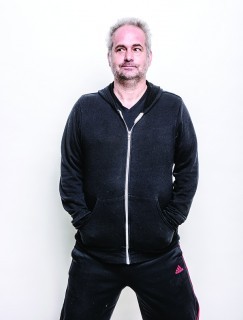
Brad Hudson. Photo: Scott Draper
At the 1979 Gettysburg Marathon, Brad Hudson crossed the finish line of his first 26.2 miler in 2 hours, 50 minutes and 35 seconds, a sterling debut by any competitive measure. The catch? Hudson, a New Jersey native, was only 12 years old at the time, and he was disappointed to have missed the American record for a boy his age by a scant 3 minutes and 26 seconds.
The now 48-year-old Hudson—who was coached by current University of Colorado headman Mark Wetmore as a grade-schooler—would go on to set a national high school record in the indoor 5,000m as a junior, and later garnered multiple All-American honors at the University of Oregon. He set his marathon personal best of 2:13:24 at Cal International in 1990, the high point of a professional career that was cut short by injury and burnout.
But where Hudson has really made his mark is as a coach. A lifelong student of the sport, Hudson has coached Olympians Dathan Ritzenhein and Jorge Torres, along with Jason Hartmann, Tera Moody and others. In 2012, Hudson had 11 of his athletes qualify for the U.S. Olympic Trials Marathon, with three of those runners finishing in the top-13. The Hudson Training Systems train continues to pick up steam heading into 2016, as nine of his athletes have already qualified for the U.S. Olympic Trials Marathon in Los Angeles next February.
What drew you to coaching?
I love the sport. I wanted to stay in the sport, and I just have a passion for it. Even when I was competing, I was always trying to learn other people’s training and asking questions about how they did it. So I always had a passion to try and do it better than I was and I’ve always loved studying training, seeing what I might have done wrong and how I could use that knowledge to help athletes train better for what they are doing.
Who have been some of your biggest coaching influences?
Renato Canova is my biggest by far. There’s no one who is probably even close. Maybe a little bit of Jack Daniels. I try to study everything and all the workouts and stuff but Renato Canova is by the most influential to me. Mark Wetmore was my first coach when I was a kid, and I’ve been coached by Pat Clohessey, Arturo Barrios, Mike Manley, Bill Dillinger, so I’ve had tons of different coaches and seen a lot of different approaches.
What is your favorite event to coach?
I would say the marathon for sure is my favorite, but honestly I like coaching all the different events. I’ve been trying to concentrate on the steeplechase more because I don’t have very super talented athletes and I think we can make more of a dent in it, even though it’s gotten more competitive this year. I like all events but if I had to pick one I’d say the marathon.
What is it that you love about the marathon?
I think it’s a very, very hard event because the training matters. It matters a lot, more so than probably most other events. You can’t get by just on talent because you’ll run out of fuel. The training very much matters. It’s a hard event to coach because there are so many different approaches and so many things to balance—if you go over the edge, you go over the edge and if you under train ‘em, they bonk. It’s a tough event to race, even when you’re in shape and running your best. It’s scary when you’re standing on the starting line thinking, “How am I going to run 26 miles at this pace?”
What are biggest mistakes you see coaches and athletes make in regard to marathon training?
Not being specific enough in their training and not looking at the demands of the event, whether it’s a hilly course or a flat course, or hot weather, or whatever it might be. A lot of people misjudge fitness with specific fitness and think they’re in better shape than they are based on something that doesn’t really correlate. There are people that get in very good shape and might be in great 5K or 10K shape or they’re doing good workouts, like 8 x 1K or mile repeats, so they think they’re amazing marathon shape. The marathon is a very specific event. Just because your VO2 max is high and just because you’re in good 10K, 15K or even half-marathon shape does not mean you’re ready to race a marathon with the demands that it has.
What’s your proudest moment as a coach to this point in your career?
When I first got into coaching I definitely wanted to prove things and like most coaches, I wanted to be successful and now, more than anything else, I think I just want to be valuable. I’m proud that I’m assembling a group of athletes that want to train together and make an impact—not only at the competitive level, but also on people’s lives.
What’s the best piece of coaching advice you’ve ever received?
That’s a tough one. I’ve received a lot of coaching advice. The best is probably just to keep learning from your mistakes and don’t be afraid to experiment but also look back at what you could have done better and go forward. Just when you think you have some sort of formula figured out for your athletes, try to find ways to do it a little better. Never be satisfied with what you know now because there’s always more to learn.
What do you like to do when you’re not writing training or coaching practice?
Right now, it’s studying poker. I just like studying the math probabilities of it, stuff like that. I don’t play it, I just study the game. And I love watching sports, almost any sport. I love watching everything.
RELATED: Last Lap with Timothy Olson: Soul Runner
The post Last Lap with Brad Hudson: The Marathon Whisperer appeared first on Competitor.com.
Ryan Hall's Blog
- Ryan Hall's profile
- 21 followers



